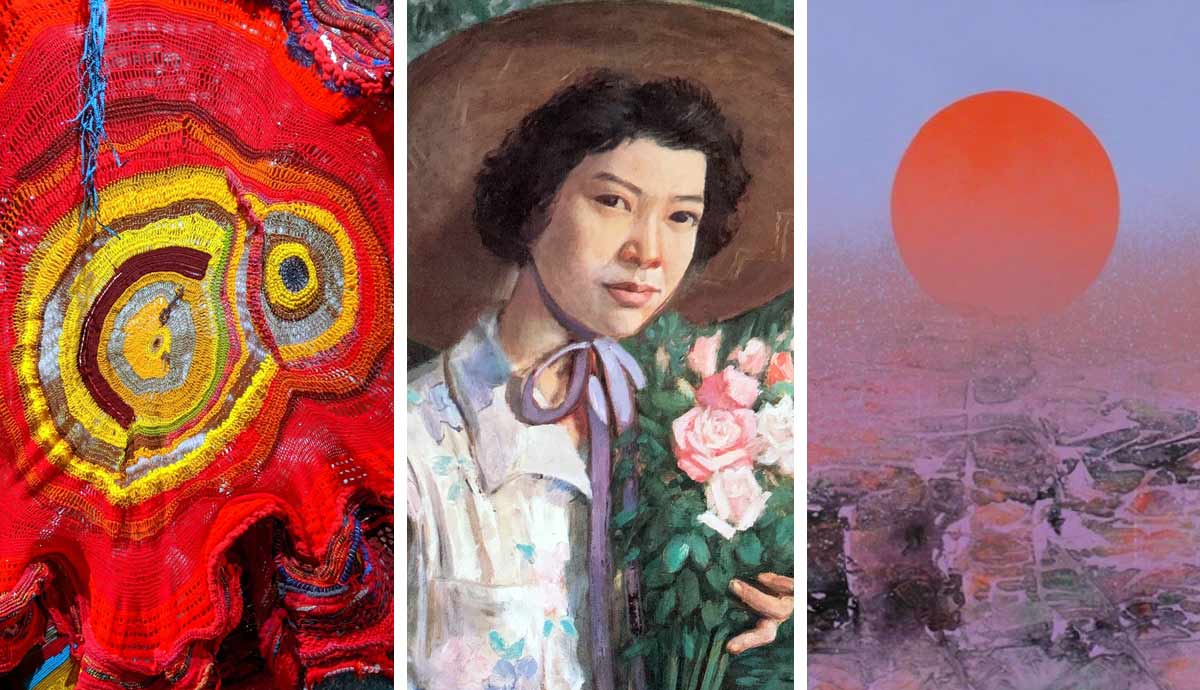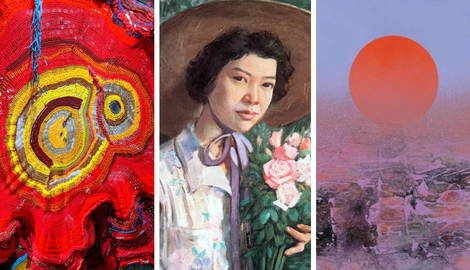
Taiwan’s art scene is often overshadowed by the Asian hubs of Singapore and Hong Kong. Despite this, it has much to offer. With an art history grounded in indigenous practice and traditional Chinese art forms, the art that emerges from it is unique and a powerful contemporary force all of its own. From the cultural hub of Taipei in the north to the nurtured local community of Chiayi in the south, Taiwan has many art museums, galleries, and events that should entice any art-lover.
The Roots of Taiwanese Art

Taiwanese art is commonly considered to be rooted in calligraphy and ceramics. Yet, its origins lie in Taiwan’s original residents. These indigenous people have lived on the island for millennia and are credited by some as responsible for the settlement of Southeast Asia and the Pacific islands. There are currently 16 recognized indigenous people groups in Taiwan, and even more are traceable throughout history. The Japanese Colonial Period (1895-1945) was a particularly challenging time, during which suppression caused clashes between indigenous tribes and the Japanese government, and impacted how groups practice their traditions today.
Indigenous art has historically centered around traditional crafts like weaving and wood carving. These crafts are often used to provide for the community, through clothing, architecture, and worship. Yet they also hold symbolic value, representing the indigenous beliefs of the artists. More recently they have aligned with the contemporary art world, blending indigenous elements with contemporary artistic practices.
Aruwai Kaumakan, for example, is a contemporary artist from the Paiwan tribe. She creates sculptures from textiles using a technique from her tribe called “lemikalik.” The weaving of circles characterizes this technique as if the artist is weaving memories that bind her tribe. Her works convey the happenings that surround her heritage, and how they are experienced by her people, particularly women. Her work has been exhibited in major art shows including at the Taipei Biennial.
Beyond indigenous art, China has also played a significant role in Taiwanese art history. Han Chinese immigration has influenced local culture since at least 1662. The migrants brought with them traditional art forms such as calligraphy and landscape painting. Under Qing rule (1683-1895) Chinese painting became increasingly popular alongside folk art that was often related to Taoism, Buddhism, and Confucianism.
The Rise of Contemporary Art in Taiwan

Following their loss in the Chinese Civil War in 1945, the Nationalist Kuomintang (KMT) arrived in Taiwan, led by Chiang Kai-Shek, and attempted to restore Chinese culture after a significant period of erasure during Japanese colonialization. They implemented martial law (1949-1987), suppressing local Taiwanese cultural expressions in favor of Chinese tradition. Despite suppression, artists began seeking their own artistic identities during the post-war era, experimenting with form and medium.
Li Mei-Shu (1902-1983) exemplifies this clash between the traditional and the modern, depicting realist local scenes in his work. He continued this style even when his interest was focused on abstract subjects in the 1950s. Alternatively, artists like Liu Kuo-Sung blended abstraction with traditional forms. Lu was particularly interested in landscapes, in which the moon was often a primary feature.
After martial law was lifted in the 1980s, and amid a period of political isolation following Taiwan’s expulsion from the United Nations in 1971, the country saw a resurgence of local artworks. Performance art, in particular, emerged as a medium of rebellion. In the present day, Taiwanese contemporary art can be described as diverse, with artists utilizing installation, performance, video, and digital art, exploring a wide range of themes within both global and local contexts. Art here draws on political commentary, focusing on Taiwan’s history, alongside its complex relationship with China.
Taipei Fine Arts Museum (TFAM): Taipei as Taiwan’s Cultural Capital

Taipei, the capital of Taiwan, is regarded as the island’s cultural center. It merges tradition, modernity, and multicultural influences, pivotal in shaping Taiwanese culture. It is home to many of Taiwan’s cultural institutions and art spaces and hosts many festivals. The city encapsulates a clash of historic influences that shape its identity, including that of Japan and the KMT, but also of earlier colonizers, such as the Dutch and Portuguese.
If you love historical objects and artifacts, the National Palace Museum is a must-visit. It houses an extensive collection of Chinese objects—700,000 to be exact—many of which were brought to Taiwan from Beijing’s Forbidden City by the KMT during the Chinese Civil War. This museum plays an important role in preserving Chinese cultural heritage. Its jade cabbage from the Qing Dynasty (1644-1912), is a popular attraction from its permanent collection.
A key institution in Taipei’s contemporary art scene is the Taipei Fine Arts Museum (TFAM). It hosts the Taipei Biennial, a significant contemporary art event in Asia that is global in its curation and artwork while also drawing attention to Taiwanese artists. Its other exhibitions similarly connect Taiwanese art with local and global themes.
Chiayi Art Museum: Focusing on the Local

Chiayi Art Museum is a great representation of how a smaller art museum can engage with the history and the experiences of its local community. The building itself blends Japanese colonial architecture with modern renovations, drawing on the city’s history. It focuses on contemporary Taiwanese art, particularly that which represents themes local to Chiayi, a province in southwest Taiwan. For example, a recent exhibition about forests drew on the role of Alishan, a stunning forested mountain located close to Chiayi City, in shaping connections to nature.
The museum also nurtures Chiayi’s artistic legacy. It is home to some of Taiwan’s most famous artists, such as Chen Cheng-Po (1895-1947), a well-known painter. The museum collects these famous artworks, which often highlight the beauty of the Taiwanese landscape. It also offers workshops, lectures, and guided tours and collaborates with local community groups.
National Taiwan Museum of Fine Art and the East Asia Biennial

The National Taiwan Museum of Fine Arts in Taichung on Taiwan’s west coast hosts the East Asia Biennial. The exhibition reflects growing regional connections, facilitating collaboration between local curators and artists. It examines shared histories, politics, cultural identity, and other issues significant in the region.
For many from the West, who are used to a euro-centric art scene, the biennial provides a great insight into the art of the East Asian region, and an alternative, likely less familiar, narrative on contemporary art. The museum also acts as a site of exchange for Asian artists, facilitating the opening of new connections and discussions.
The 2022 edition of the biennial, Phantasmapolis, examined “Asian Futurism,” exhibiting both historical and contemporary works that examine the future. The goal of the exhibition was to “reexamine the past and present of Asia through sci-fi perspectives.” It represented a variety of themes from sex and gender to the body and family, to further explore the possibilities of the future. The 2024 iteration, How to Hold Your Breath, looks to explore mindfulness through the lens of contemporary art.
Buying Art: Taipei Dangdai and Art Taipei

Taipei hosts the country’s two major art fairs: Dangdai and Art Taipei. First launched in 2019, Taipei Dangdai quickly became one of Asia’s main art events, celebrating the local and global art scene. It hosts a range of galleries, from more established to young and up-and-coming. It also showcases the works of individual artists, as well as larger and specifically curated installations. To make collecting more accessible, the fair also features a salon that offers more affordable work. A growing community of collectors visit Taiwan specifically to attend, and the islands are home to some of Asia’s most influential art collectors. Taipei Dangdai takes place in January, thus setting the tone for the art market in the year ahead.
Established in 1992, Art Taipei is one of the oldest international art fairs in Asia. Like Taipei Dangdai, it features a wide range of both international and Taiwanese galleries. However, though contemporary art is a feature, traditional Chinese art plays a greater role in the fair, which caters to more local collectors. Major contemporary artists show their works, as well as emerging ones and younger galleries. It also features large-scale public art projects and hosts various events including artist talks and forums. As must-visit events in the art calendar, both fairs demonstrate Taiwan’s increasing importance as a hub of contemporary art.










